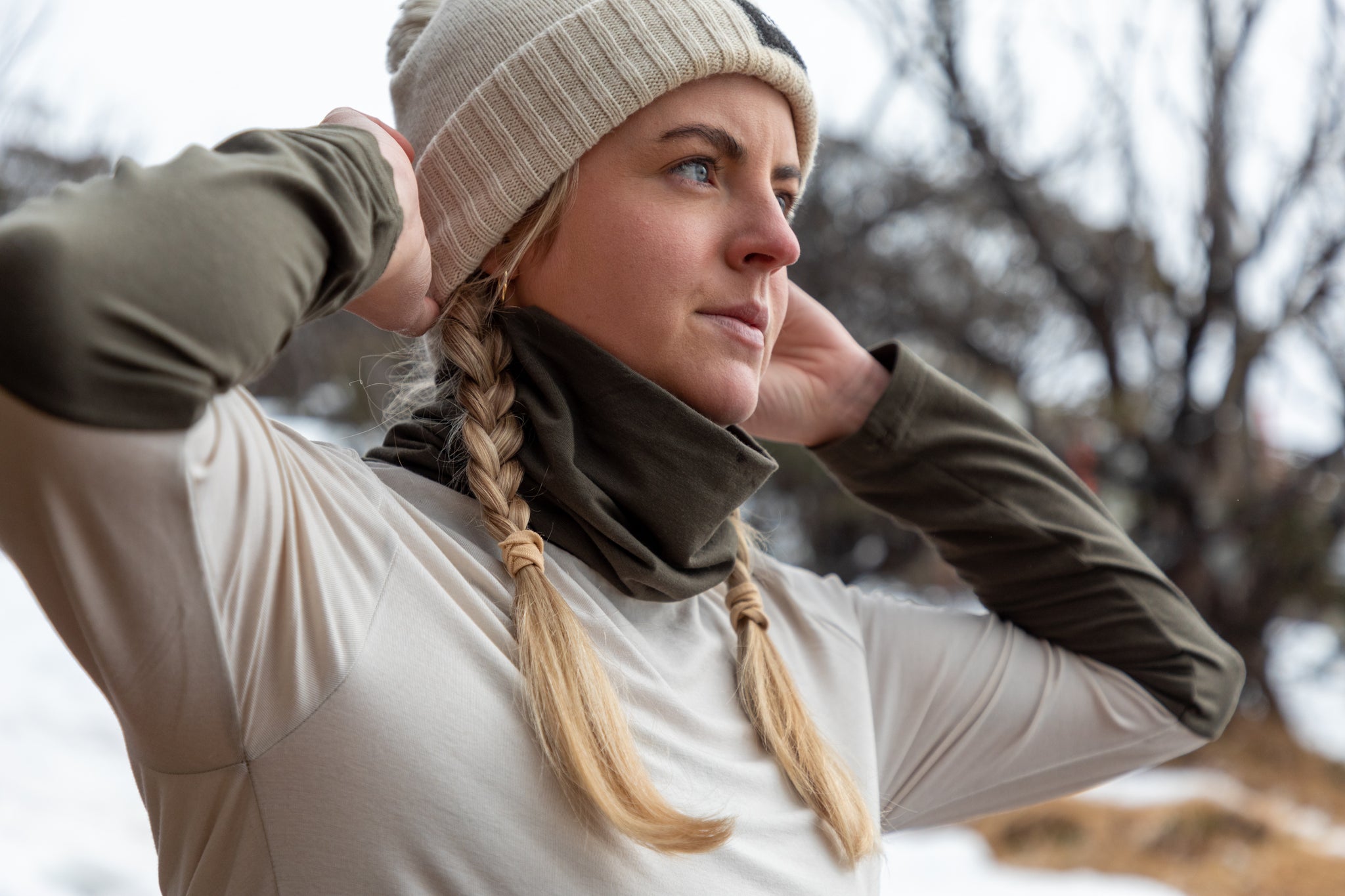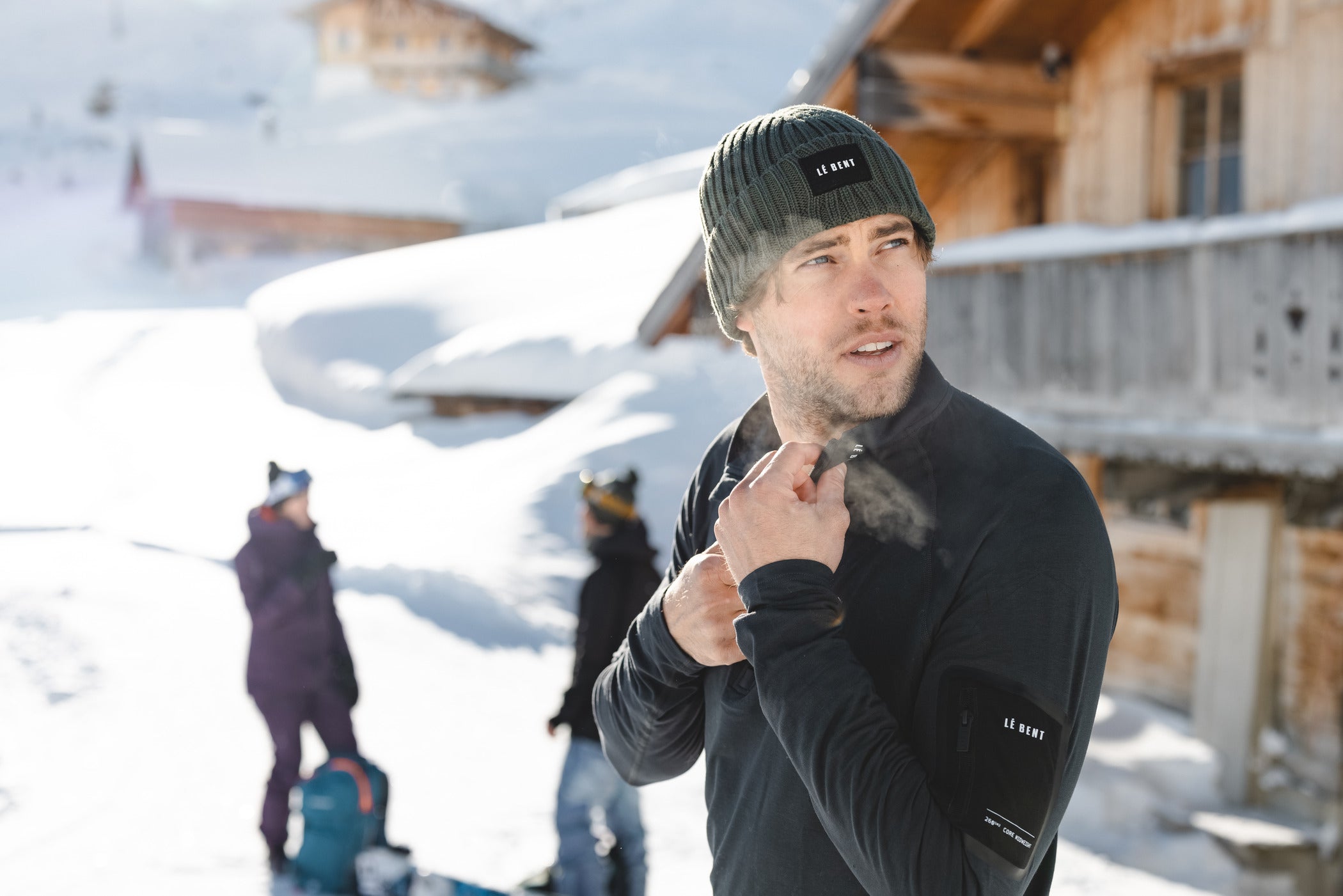Getting outside to exercise in the winter months presents unique challenges. Those below-freezing temperatures increase your chances of getting frostbite or hypothermia, and that possibility can cause a lot of active people to want to stay indoors.
The biggest challenge is striking the right balance between protecting your skin and body from low temperatures and harsh wind and avoiding the dreaded overheating. This is where your base layer becomes exceptionally important. A merino wool base layer can make all the difference when skiing, hiking, or even camping in the winter.
Ready to learn more about creating the perfect base layer? Read on for our guide to the best base layer for cold weather and why a blend of merino wool is the way to go.

Three Base Layer Factors to Consider
Layering is a crucial part of navigating the outdoors in winter months. Unlike middle and outer layers, your base layer is tasked with managing sweat and moisture as much as it is tasked with keeping you warm. Let's take a closer look at the three most important base layer factors.
Material
When selecting a fabric for your ski base layer, you're looking for a material with strong wicking properties. Wicking is the ability some materials have to pull sweat and moisture away from the skin, leaving you dry even when you're cool. For example, Merino wool has strong wicking properties, which is why sheep can regulate their temperatures supremely well whether it is hot or cold. Moisture wicking and thermoregulation go hand in hand.
Weight
Weight refers to the material's density and the warmth it can provide. You're looking at three basic categories: lightweight, midweight, and heavyweight. We'll talk more about choosing your base layer weight later on.
Fit
Wicking fabric can only do its job if it's touching your skin. While you don't want to feel suffocated by your base layer, you want a slightly more snug fit than your typical long sleeve tee shirt. When doing something like skiing, you'll want to select a base layer that provides plenty of flexibility without losing its elasticity.
Underwear Fabric Options
The fabric you choose is quite important when putting together a base layer. Your skin is often more sensitive in the winter because that cold, dry weather can cause your skin to become flaky and irritated. Avoid fabrics that are harsh on sensitive skin, and opt for one of these soft, smooth, wicking fabrics instead.
Synthetic
Synthetic fabrics are often touted for their wicking abilities and may be the right choice for some skiers. However, a standard synthetic material used for wicking base layers is polyester, which may be tough on sensitive skin. Synthetic layers i.e. made from polypropylene (plastic) are also more harmful for the environment and don’t have the same odour suppressing properties as natural fibres like wool.
For this reason they tend to be cheaper.
Silk
Silk has moderate wicking properties and is suitable for low-impact activities like leisurely hiking. Silk is quite supple and soft, available only as a lightweight option. It's worth noting that unless treated with an anti-odor finish, silk will retain odours and should be washed between each use. It is also not a very durable fabric.
Ceramic
Wool infused with ceramic particles is one of the newer materials to hit the base layer market. Ceramic base layers are designed for hot weather use and aren't a necessary base layer for skiing or other cold weather activities. The ceramic particles attract body heat and allow the skin to cool down rather than simply wicking away moisture.
Merino Wool
Finally, we have our favourite base layer clothing option: merino wool, which is far softer and less itchy than the wool of the past. Merino wool is an ideal base layer material for both cold and hot weather due to its ability to wick moisture and release heat. In addition, Merino wool is one of the most odour-resistant fabrics out there, and you can go days without washing your merino wool base layers before noticing a single unpleasant whiff.
To build upon the benefits of merino wool, some base layers may also feature a blend of merino. LÉ BENT’s Signature Merino Blend for example, combines rayon from bamboo with the merino to provide further softness - akin to cashmere.
A Note on Fabric Weight
Now, let's talk a bit more about selecting your fabric weight. Fabric weight is crucial when putting together your layering system for cold weather activities.
Fabric weight can be something of a personal preference and will also depend on the insulation of your ski or snowboard jacket as well as the temperatures in question.
As a general rule, for the higher intensity activities, we’d advise a lightweight base layer paired with a mid layer and outer jacket. That way, as you start to heat up from exertion on the slopes, you have the option of shedding your mid layer and maintaining an even temperature. When you wear fewer layers, your options are more limited.
A good rule of thumb to go by is; the heavier the weight, the warmer you’ll be.
Lightweight
Lightweight base layers can do it all. Typically in the 200gm range, these layers can be worn off the ski hill in mild conditions, or be used as the first building blocks in your layering system while skiing. They are the best selling base layer for good reason.
Midweight
Midweight base layers are built for those who feel the cold more or are skiing and snowboarding in harsher climates. These layers are around 260gm and are noticeably heavier.

Comfort Is Everything When It Comes to Base Layers
Remember, your base layer is coming into direct contact with your skin. You want something that will keep you dry, won't contribute to skin irritation, and will give you the flexibility you need to hit the slopes or trails. LÉ BENT has worked hard to perfect the base layer for both men and women (and even kids).
Our men's base layer line includes boxer briefs, long underwear, long-sleeve thermal tops, and more. Each piece is made from our unique Signature Merino Blend.
Similarly our women's base layer system includes underwear, leggings, long-sleeve thermal tops, and more. Once again, each piece is made from our unique Signature Merino blend.
What Makes LÉ BENT Base Layer Technology Unique?
Why is LÉ BENT merino wool different? We've combined traditional merino wool with a rayon material derived from bamboo to create a fabric that is as soft as cashmere, temperature-regulating as ceramic, ultra odour suppressing and moisture-wicking. Plus, our fabric has UV-blocking technology to keep your skin safe and healthy when you're outdoors.
Stock Up on Base Layers at LÉ BENT
If you're looking for the best base layer for cold-weather activities, you've found it. LÉ BENT is proud to offer top-of-the-line merino wool base layer options.
Learn more about the LÉ BENT base layer technology or dive right into our base layer collections for men, women, and kids.








